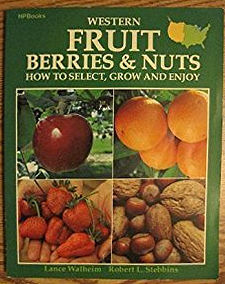|
This legacy book has been important to Ecology Action's work and is highly recommended by John Jeavons. He describes it as containing more information on fruit-growing "than one person could learn in three lifetimes." The writers obviously love the subject and took the time to present it in a complete, well-formatted and reader-friendly way. A huge amount of detail is included, and vibrant color jumps out from almost every page, even from the charts. For example, there's a beautiful color collage of 30 popular varieties of apples, followed by detailed information about caring for and harvesting this fruit, plus five pages of charts with the origin, zone, harvest season, description and remarks about 46 varieties. Then when it seems apples have been fully covered, there is another color collage and chart about 12 older apple varieties! There are also charts for pears, peaches, nectarines, sweet and sour cherries and plums, that show the dates different varieties are ready to harvest. Using this, a person could choose varieties that would give them a longer season to enjoy a particular fruit. For example, someone planting a carefully planned selection of apple trees could have that fruit to eat from June to December. The book breaks down a large number of geographical areas from coastal Washington to Montana, from high elevations in Arizona and New Mexico to southern California, and all states in between, and briefly discusses fruit-growing in each area. There is also a discussion of pests and diseases by climate zone. Another section discusses pruning and training fruit trees, with helpful drawings on how to prune various types of trees in their different growing seasons—from newly planted to mature. IMAGE CREDIT: amazon.com/Western-Fruit-Horticultural-Publishers/dp/0895860783
The authors highlight five main causes for the price of food increasing so greatly over the last few years: the rise in oil prices, rising meat consumption, climate change, agro-fuels, and speculation in grain futures. Also important is the decreasing percentage the farmers receive from each food dollar. In the 1950s it was 40% to 50% whereas today it is only around 20%. However, the authors believe that the major factors in our broken food system are "global monopolies of the industrial agrifood complex, with the help of international finance institutions and the complicity of governments." IMAGE CREDIT: gottesman.pressible.org/ttl2117/ food-rebellions-crisis-and-the-hunger-for-justice top | Newsletter Home |Table of Contents| Archive
|


 Western Fruit, Berries and Nuts: How to Select, Grow and Enjoy
Western Fruit, Berries and Nuts: How to Select, Grow and Enjoy 
